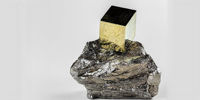Posted on December 20, 2021

By Paul Vanguard, for BullionMax.com
Price forecasts for any assets can be tough. Big banks, with their teams of hundreds of highly-trained analysts, get it wrong a lot more often than not. Sometimes, just to keep things interesting, they get it very wrong.
Instead of pretending to have a crystal ball or a time machine, we'll focus on the underpinnings of the precious metals market. As we head into the new year we'll see whether we can divine where gold and silver might be headed, too.
One forecast we aren't willing to doubt is that of Saxo Bank, whose team expects inflation to hit 15% next year. For some perspective, John Williams' ShadowStats, which offers an exceedingly more accurate view of inflation than the Consumer Price Index, tells us that the inflation rate is already between 10% to 15% based on the Federal Reserve's accurate (yet retired) measurements. Within two years, we have managed to make the awful inflationary period of the 1970s that nobody wants to remember look like nostalgic.
We can also talk about the Basel III agreement. The mere mention of it causes unrest among banks. They want to continue trading paper gold with no backing, but the window is slowly closing. It's only closing slowly because most regulators and not a few bankers fear that a full implementation could partially or wholly collapse the financial system. The association of bullion markets based in London, as it has been pushing for as many delays as possible. They think that actually implementing this procedural change would put banks into crisis without a solution.
Well, maybe they shouldn't be so enthusiastic about trading paper gold, this wouldn't be a problem? Way back in 2012, the ratio of actual gold bullion bars to "paper gold" trading on COMEX was 16.6 to 1. That means, if everyone who owned paper gold asked for physical delivery, there'd be 15.6 extremely unhappy people for every delivery (or that paper-gold owners would get 1/16th as much gold as they thought).
So what we're looking at a slow-motion implementation of commonsense rules that should have been there from the start. Even so as the agreement itself notes, Basel III will make gold a risk-free asset and do plenty for the spot price.
Silver isn't as covered, or propelled forward, by the Basel agreement. But it's made up for by a global push to use more and more technology that relies on silver. And if the manufacturing industry halts for an undisclosed period of time, we're going to see a wave of buyers pouring into an undervalued safe-haven asset. What we think of as the "truest" form of silver demand, sales of silver coins and bars, is on course to reach a six-year high.
Yep, a six-year high. Bigger than the pandemic panic. Bigger than the Reddit-engineered attempt at a "silver squeeze."
So there's ample demand, on both investment and industrial sides. How's supply?
Significantly less healthy… Silver is on course for a supply deficit for the first time in six years. Now, an annual deficit of 7 million ounces isn't setting the market on fire, but it's good news for price (unless you're a solar panel manufacturer or you run an electric vehicle factory).
Silver seems like it's in a good place. And somehow, it still takes 80.19 ounces of silver to buy a single ounce of gold. Just to give you an idea of how astonishing this is, the historical average ratio is about 15:1. It's like an ongoing and seemingly unsustainable test of just how skewed the gold-to-silver ratio can get, for how long.
Were silver to revert, right now, to this 15:1 ratio, we'd be looking at $120/oz. silver.
Will that happen? Maybe, but the odds are darn long. There are a lot of factors at play without even invoking the cries of "Price suppression! Market manipulation!" There's a very interesting discussion here that's worth reading.
We'll sum up by saying the future looks bright for silver.
And for all the agreeing with each other that governments are doing these days, there still seems to be a bit of disagreement. Multiple nations have stated over the past few years, somewhat conspicuously, that their newly-acquired gold hoard gives them sovereign clout.
In other words, central banks seem eager to start off another decade of net buying. The year so far has very much been in line. And we know that central bank buying is one of the most important drivers of gold prices given the sheer size of purchases.
Any one of these points could form the grounds for a bullish forecast for gold and silver with lots of upside. With all of them together, we'll go ahead and say we're very optimistic on price prospects in the coming year.
Paul Vanguard is a lifelong precious metals enthusiast and a proud member of the BullionMax team.